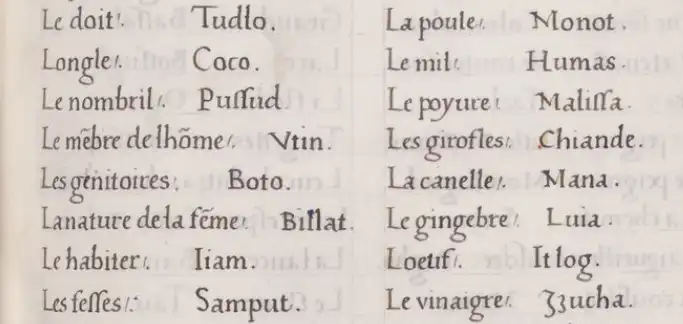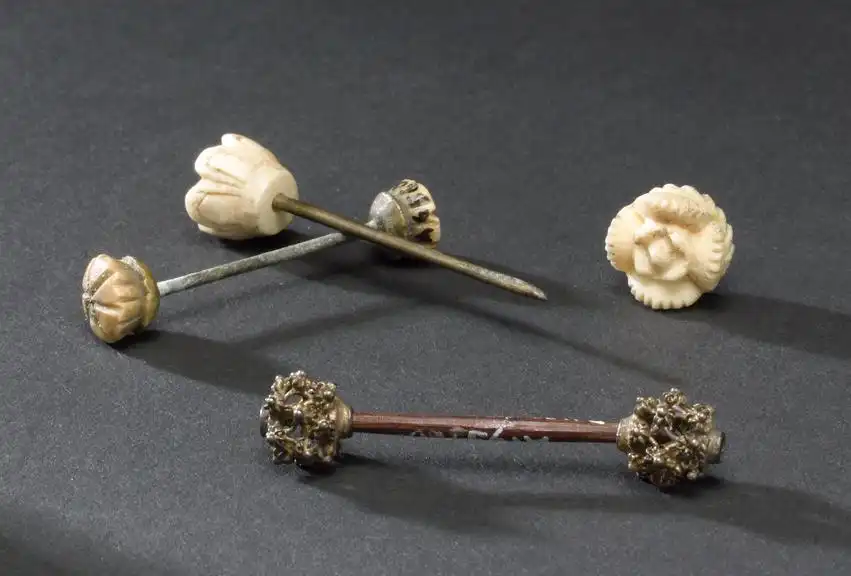
Sakit kag Kanamit: Genital Accessories in Ancient Visayas

Antonio Pigafetta, the chronicler of Magellan’s journey, scrunched his eyebrows and looked closely. In full view were “[l]arge or small” Visayan men with their heads pierced “from one side to the other” with “a golden spike as thick as a goose quill.”1 These piercings weren’t cheap, as many were, as just mentioned, made of gold. The more he looked at the piercings, the more disgusted and engrossed he became. He had never seen such novelty before. In fact, what he saw would’ve been anathema back home in 16th century Europe, enough to cause scandal and certain persecution. But on the other side of the world where they found themselves in, in what is now Cebu, Philippines, the people [Visayans] they encountered wore their piercings nonchalantly, without malice nor concern as it was the norm of the land.
Arrows launched in Europe’s many wars pierced many unfortunate heads, so the sight of such wasn’t at all disturbing to European sensibilities. So why was Pigafetta so flustered? Here comes the interesting bit: he wasn’t talking about actual heads, that which hold eyes, nose, ears, and all that evolutionary excess. Nor was he talking about the clan head or the chief who the locals called dato. What Pigafetta was talking about was how the Visayans pierced the heads of their boto,2 one of the Visayan words for the male sex organ.
For Pigafetta and the rest of Magellan’s crew, the idea and practice of genital mutilation wasn’t that unusual. The Bible, Europe’s foremost moral manual at the time, stipulates that circumcision, the trimming of the foreskin by various means, is a covenant between humans and God the creator. In Genesis 17, God commands Abraham that he should get circumcised and all his descendants must follow his example. Whosoever fails to graft their genitals “will be cut off from his people”, says God, for “he has broken my covenant.” The penis, therefore, became the de facto male passport to salvation and a trimmed tip the VISA necessary to enter heaven.
Unbeknownst to Pigafetta, the Visayans also mutilated their penises to reach paradise, albeit of a different heaven. It was later revealed to him that the use of such implements was to elevate the sexual ecstasy women experienced during sex. This of course unsettled Pigafetta, leading him to describe the Visayans as a people “de nature et complexion debilles” [of feeble nature and complexion]. Ancient Visayan women, he says, preferred to have sex with men who wore such piercings; and during intercourse, it was them, the women, who guided the ornamented organs inside their orifices.3 The sight of these accessories was an eyesore to the Europeans and the words they used to describe the piercings reflected the righteous indignation stirred in them whenever they saw one or two in full display. Miguel de Loarca, writing in Arevalo, Iloilo in 1582, described the piercings as “una cosa muy abominable” [a very abominable thing], adding that there were about twenty kinds of ornamental spurs that Visayan men attached to the ends of their pins.4

A 19th century penis pin from Borneo locally known as ‘palang’. The penis piercings Pigafetta saw in 1521 probably looked like this. Image from the British Museum.
The Spaniards were puzzled and perplexed at how promiscuous the Visayans were and how much they enjoyed the use of their genital piercings, which was, according to the late 16th century anonymous writer of the Boxer Codex, a “constumbre inbentada por el dimonio” [custom invented by the devil]. The Visayans were “todo un dia o una noche pegados y asidos el uno con el otro” [stuck all day or night clinging to each other] while “sintiendo en esto gran delectacion mayormente las mugeres” [feeling great delight in this, especially the women]. Moreover, the writer claims that there were more than 30 varieties of spurs, more than Loarca’s count, and each had a different name, although in general they were called sacra. When all the indulgent sex proved too much for the Spaniards, they enacted a ban on the sacra, punishing those who they found wearing it, hoping that it would calm Visayan loins. However, the Visayans were able to circumvent the prohibition by making visually subtle spurs that escaped Spanish surveillance.5 Antonio de Morga, in his 1609 Sucesos de las Islas, decried the fact that “aunque vierten mucha sangre, y reciben otros daños” [although they lose so much blood and experience other pains] when they have sex with the penis pins on, the Visayans still “pasan por ellos” [go through them]. Over the years, however, the threat of punishment and spread of Catholic morality overcame sexual desires, and the use of such genital accessories eventually faded.6
Piecing together the documentary evidence presented above clarifies how the sacra had been banished. But it fails to address one important question: what spurred (pun unintended) the Visayans to pierce their penises in the first place?

More ‘palang’ from Borneo. In the Visayas, the spur is called ‘sacra’ or ‘sacla’, while the long thin tube is called ’tugbuc’. Image from the Science Museum Group.
There is reason to believe that, as Southeast Asia was (and still is) a dynamic web of maritime communities, the practice of penis mutilation may have started somewhere in the region then spread outwards, developing into unique local forms. If that’s the case, then it’s necessary to look for other documentary evidence to prove possible connections. Textual records from precolonial Philippines are scant, maybe non-existent even, as ancient Filipinos weren’t that keen on writing down their histories. If such records do exist, it’s most likely that they’ve partially or largely decomposed since ancient Filipinos wrote on palm leaves that naturally degrade over time; perhaps some are still waiting to be discovered; or, unfortunately, many may have been deliberately destroyed. Since looking inwards may yield nothing, it’s necessary to look elsewhere. Luckily for this investigation, outside accounts of genital mutilation do exist. One of the earliest reports regarding such practices in Southeast Asia comes from the Chinese voyager Ma Huan, who might have seen it firsthand or heard of it in the course of his long travels. He wrote in 1433 that in Siam (now Thailand):
“When a man has attained his twentieth year, they take the skin which surrounds the membrum virile, and with a fine knife. . . open it up and insert a dozen tin beads inside the skin; [then] they close it up and protect it with medicinal herbs.”7
The next recollection comes from a European. When the traveler Jacques de Coutre was stuck in Siam in 1595, he made the most of his time by walking around and paying close attention to how the locals went about their daily lives. He then logged his many observations in his journals which were posthumously published. One of the things that piqued his interest was the very same practice recorded more than a century ago by Ma Huan. De Coutre wrote that in Siam and neighbouring Pegu (now Bago, Myanmar):
“…all the great gentlemen, whether of medium or small stature wore at the head of their penises, inserted inside the flesh, two bells which they call bungkals. They are as big as nuts and they tinkle like bells, but quite loudly; and the more noble gentlemen wear two and four more [emphasis mine].”8
In the operations mentioned above, the use of the pin, or tugbuc, is absent. This suggests two things: either bells, or bungkals, were a more primitive form of Southeast Asian genital ornaments or they were later iterations that did away with the need for a pin. Whatever the case may be, what they ultimately signify is the fact that penis mutilation was quite widespread in Southeast Asia although the means by which it was observed varied.
Aside from the material and methodical difference, there is also an observable contrast in purpose and utility, especially as sexual accessories. The locals told de Coutre that inserting bells in the penis was an order by the queen of Pegu as a preventive measure because her subjects were “very inclined towards sodomy.”9 Those who were caught without it were “scorned as sodomites”.10 This restrictive motif rings opposite to what the Visayan penis pins were intended for: the promotion of sexual activity and pleasure. But it isn’t sex per se that the bells were designed to prevent, but only homosexual sex between men. There are no historical records currently available that detail the use of penis pins in homosexual relations among ancient Visayans although there are accounts of men consorting with other men.11
Sex is the only thing that clearly connects the pins with the bells. Although the sacra is quite analogous to the bungkal, a direct lineage between the two is hazy, likely nonexistent. It’s also possible that the development of each was convergent; that is to say, both emerged at roughly the same time independent of each other but reached a certain commonality as they developed–in this case, as sexual accessories. With this in mind, we can comfortably draw a scenario that doesn’t sacrifice historical accuracy altogether for speculation: at some point in the distant past, the ancestors of Southeast Asians found that mutilating the penis had variable effects on social and sexual behaviours and then their descendants used this discovery for their unique needs. In Pegu and Siam, it was a means to prevent sodomy. In the Visayas, it was to further satisfy the women.
Since variability often increases with time and distance, perhaps the best evidence for a Southeast Asian origin, or connection at the very least, comes from a closer source. Indeed, in the nearby island of Borneo, we find a similar practice still being observed in the late 20th century, all with pins and spurs.
The rise and rule of the Malay Srivijaya thalassocracy starting from the 7th century helped disperse Malay culture and language throughout the kingdom’s reach. Though there is no direct evidence pointing to the inclusion of the Philippine archipelago to its sphere of control, the loose and fluid nature of Southeast Asian polities make it quite certain that the Srivijayans did exercise some form of authority over the islands. This placed the many communities of precolonial Philippines within a discernible network teeming in commercial and cultural activity. But like all mighty kingdoms, its days of glory would soon end. Unable to withstand the challenges of rival kingdoms from Ayutthaya, Sukothai, Java, and China, Srivijaya ultimately collapsed in the 14th century.12 But while it sunk to the depths of political obscurity, its history kept afloat a legacy of open exchange between far-flung maritime communities that continued for some time. Pigafetta’s journal even captures the extent of its influence in the 16th century. In his short documentation of Visayan vocabulary, we find a substantial number of Malay words that are still used by speakers of Bahasa Indonesia and Bahasa Melayu (like perempuan for woman).13

Some Visayan words that Pigafetta recorded. Many are still in use today, like the ones referring to genitals.
This shared language is a faint trace of what was once a close cultural kinship. Decades—or even centuries—of trade, migration, and/or warfare between these maritime communities have created strong cultural links that stretch beyond the seas. As trinkets, minerals, produce, and slaves were sent to and fro, so too were cultural practices. So its no surprise that some Malay tribes in Borneo also use penis pins which they call palang. And more than just a similarity in form, the sacra and palang also share the same purpose: to ensure the sexual satisfaction of women.
Nowhere is this desire to please women more evident than in the origin story of the palang provided by the Kayans, a tribe from Western Borneo. According to their recollection, a naked girl was once sleeping on the floor when a dog entered her abode and licked her vagina. She found this to be pleasurable so she experimented with a leaf to test if she could stimulate herself. The trial was successful, and whenever she found herself all alone she would pleasure herself with a leaf to feel good. Some time later, she found a young man whom she had sex with. After the act, she admitted to him that the experience was no better than if she did it by herself with a leaf. This failure to please her deeply perturbed the young man, and he blamed anatomy, not his raw performance, for the gaffe. He mulled the problem over and on the next day immediately sought to redress his deficiency by going to the forest, and, with whatever material that was available around, pierced his penis and adorned it with a pin. Once the wound was healed, he met up with the girl again and had more sex, and this time, she was left satisfied every time.14
The details of the narrative are doubtful, but the theme remains clear and consistent with what is known about penis pins in Southeast Asia if we are to read it carefully. By removing the thick layers of moral blinders, it’s easy to see a current of female authority running underneath Visayan and Bornean consciousness. For whatever reason, the sexual satisfaction of women was a paramount need for them. Whether it be in the Visayas or in Borneo, a number of men were/are willing to endure pain and possible fatal infection just to install accessories on their genitals that guarantee pleasure for the women they had and have sex with.
And it seems that they do it with genuine feelings of adoration. Loarca writes that the Visayans “quieren mucho a sus mugeres” [love their women so much].15 Perhaps it is this same love that drives them to extremes for the benefit of their beloved: a kind of love that is willing to go to hell just to make others feel like heaven. But adopting this view allows romanticism to cloud sober judgment. Those that relayed such information to Europeans were mostly men themselves, so we’ll never know what Visayan women actually thought about these pins. Were they the ones that imposed its use on the men because they did find it satisfying when men wore them during sex? Or did the men reach that conclusion because wearing it was pleasurable to them and assumed the same for the women?
The answer is: we’ll never know. There’s just not enough evidence. And though it’s tempting to simply take the testimonies as canonical truth, science and proper research advise us to remain circumspect and diligent. Like Pigafetta, we’re left scrunching our eyebrows and looking intently at the scant textual and material records available, trying to make sense of it all as we scratch our heads in confusion. Heads as in that which hold eyes, nose, ears, and all that evolutionary excess. Not the heads that may or may not have pins pierced through them.
-
Antonio Pigafetta, The Voyage of Magellan: The Journal of Antonio Pigafetta, trans. Paula Spurlin Paige (New Jersey: Prentice Hall, 1969), 72. ↩︎
-
Described in Alonso de Méntrida’s 1637 Bocabulario de lengua bisaia hiligueyna, y haraia de la isla de Panai y Sugbu as “membrum virile”. ↩︎
-
Antonio Pigafetta, Journal of Magellan’s Voyage. (1525) [Manuscript] Held at: Yale University Library. Beinecke MS 351, 47r. ↩︎
-
Miguel de Loarca, “Relacion de Las Yslas Filipinas,” in The Philippine Islands: 1493-1898, ed. Emma Blair and James Robertson, vol. 5 (1582–1583) (Cleveland, OH: The Arthur H. Clarke Company, 1903), 116. ↩︎
-
George Bryan Souza and Jeffrey Scott Turley, eds., The Boxer Codex: Transcription and Translation of an Illustrated Late Sixteenth-Century Spanish Manuscript Concerning the Geography, Ethnography and History of the Pacific, South-East Asia and East Asia (Leiden: Brill, 2016), 75-76. ↩︎
-
Antonio de Morga, The Philippine Islands, Moluccas, Siam, Cambodia, Japan, and China, at the Close of the Sixteenth Century, ed. Henry Edward John Stanley (Cambridge: Cambridge University Press, 2010), 304. ↩︎
-
Ma Huan, Tyingya Shenglan: The Overall Survey of the Ocean’s Shore, trans. J.V.G. Mills (Cambridge: The Hakluyt Society, 1970), 104. ↩︎
-
Jacques de Coutre, The Memoirs and Memorials of Jacques de Coutre: Security, Trade and Society in 16th- and 17th-Century Southeast Asia, ed. Peter Borschberg, trans. Roopanjali Roy (Singapore: NUS Press, 2014), 136–37. ↩︎
-
Ibid. ↩︎
-
Ibid, 138. ↩︎
-
Fransisco Ignacio Alcina, The Muñoz Text of Alcina’s History of the Bisayan Islands (1668), trans. Paul Lietz, vol. 3 (Chicago: University of Chicago, 1962), 198. ↩︎
-
Keith Taylor, “The Early Kingdoms: Srivijaya,” in The Cambridge History of Southeast Asia: From Early Times to c. 1800, ed. Nicholas Tarling, vol. 1 (Cambridge: Cambridge University Press, 1992), 175. ↩︎
-
Pigafetta, Journal of Magellan’s Voyage, 51v-53r. ↩︎
-
Tom Harrisson, “The ‘PALANG,’ Its History and Proto-History in West Borneo and the Philippines,” Journal of the Malaysian Branch of the Royal Asiatic Society 37, no. 2 (1964): 165–66. ↩︎
-
Loarca, “Relacion”, 116. ↩︎
Did you like what you read? Then consider subscribing to the Bibliotikal newsletter to get immediate alerts on new posts, local history news, and activity announcements.
Share on: